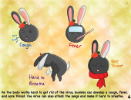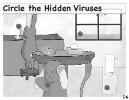Students Create Children’s Story to Explain COVID-19
Published July 8, 2020 This content is archived.
story based on news release by michael andrei
Two students in the medical education program — Natalie Tjota and Sara Xu — are using colorful images of Berry Bunny, an original character they created, to explain the novel coronavirus in a clear way to students in elementary and middle school as well as junior high.
A Need for Child-Friendly COVID-19 Facts
The story, “Berry Bunny Learns About COVID-19,” also includes activities aimed at younger readers. The book is available at no cost through the Berry Bunny website.
Tjota notes there is a need for younger students to have information directed toward them at their level. “And on the topic of coronavirus, I think it is especially important.”
Xu says she believes that “this is a difficult topic for everyone to understand ─ not just kids but adults as well. And our story format, not being text-heavy, with illustrations, could work well as a teaching tool for everyone about coronavirus. Berry Bunny is a friendly story, but I also see it as a truthful source of information.”
Service Learning is Important at Jacobs School
“We are very fortunate to have creative and caring students who are willing to help educate young students in such a complicated subject,” says David A. Milling, MD, senior associate dean for student and academic affairs.
“Service learning is an important part of what we do. The Jacobs School has been involved with the New York State Mentoring Program for two years now, and this project fits in very well with what we are doing in this program,” Milling says.
“Their effort to teach younger students about the topic of this virus also shows who Natalie and Sara are as medical students and who they will be as physicians.”
Drawing from Workshop-Planning Experience
Tjota, who graduated from the University of Rochester in 2016 with a bachelor’s in biomedical engineering and a bachelor’s in East Asian studies, drew from prior experiences while developing the book.
“As an undergrad, I organized workshops for the local Girl Scout troops to come to campus and learn about engineering,” she says.
“Coincidentally, UB hosts a similar annual program called Girl Scouts Go to Medical School that I was able to help organize last year. We put together activity stations and a little guide book to teach the girls about the different systems in the human body.
“I put my experience planning the Girl Scout workshop and drive together to present information to kids about coronavirus in our project.”
“During a video chat I was having with my two nephews back in March, with COVID-19 clearly becoming something that would be affecting all of our lives in one way or another, I wondered how much they knew about the virus,” Tjota says of her nephews, who are ages 7 and 4.
“The topic did not come up in our chat, so I started to think about how they and other children their age were learning about and coping with changes brought by coronavirus.”
Using Knowledge Gained from Tutoring Youths
In drawing illustrations for the story, Xu created Berry Bunny as a way to tell a friendly story about coronavirus, a decidedly unfriendly topic, to young students.
“I thought about children’s books I’ve read,” says Xu, who is from Rochester and also holds a bachelor’s in East Asian studies.
“Many authors choose to use animals to tell stories. It’s one way, I think, for younger readers to more easily see themselves in the role of the characters,” she says.
Xu, who is working toward a medical degree with the goal of pursuing a career in psychiatry, says she spent time tutoring grade school-aged students while she was at the University of Rochester.
“I think kids understand a lot more than we often give them credit for,” she says. “It’s important that we tell the truth and provide facts, even as we make the delivery more child-friendly.”
Translations Provided by Classmates
Their story is available in English, Spanish and Chinese versions.
The translations were provided by the authors’ friends and fellow Jacobs School classmates Kaity Tung and Hillary Jaramillo.
Helping Children Understand on Global Level
Since the book’s release, it has been viewed by thousands of people in 42 states and 35 countries.
Additionally, it has been featured on a list of COVID-19 resources by the New York City Department of Education.
It has also been featured on the YouTube channel of Every Person Influences Children, a local nonprofit that helps families, schools and communities raise children to become responsible and successful adults.


